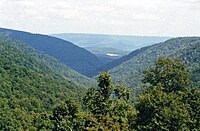Blue Knob (Pennsylvania)
Blue Knob (elevation 3,146 feet (959 m)) is a summit in the eastern United States with a broad dome that is the northernmost 3,000-footer in the Allegheny Mountains.
The mountain is the site of 5,874-acre (23.77 km2) Blue Knob State Park and contains approximately 18 miles (29 km) of hiking trails and numerous overlooks.
Adjacent to the mountain on the Allegheny Front are Big Break Hollow and Wallacks Branch, portions of these streams are located within the State Park boundary.
Blue Knob is separate from the rest of the Allegheny Front escarpment, and the mountain's lower base is made up of siltstone and shale of the Devonian Catskill and Devonian-Mississippian Rockwell formations.
The upper slopes and summit are made up of the buff-colored Mississippian Burgoon Formation of sandstone and conglomerate, which is far more resistant to weathering than the underlying shale and siltstone.
Blue Knob was thought to be the highest mountain in Pennsylvania until 1921, when the U.S. Geological Survey determined a summit of 3,213 feet (979 m) was higher (later named Mount Davis).
The upper slopes of the mountain have Black Cherry, Striped Maple, Scrub Oak and a forest floor of blueberry and fern.
Species such as white-tailed deer, ruffed grouse, turkey, coyote, porcupine and fox are difficult to see, but finding their tracks in the snow is not uncommon.




